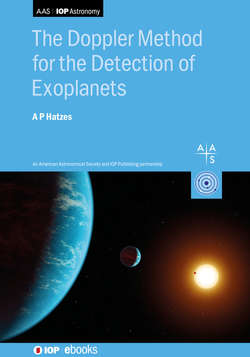Читать книгу The Doppler Method for the Detection of Exoplanets - Professor Artie Hatzes - Страница 46
На сайте Литреса книга снята с продажи.
3.2.1 Stellar Rotational Velocity
ОглавлениеIn the absence of stellar variability, stellar rotation has the largest influence on the RV measurement error. Rotation broadens the width of the stellar lines and makes them shallower, thus making it more difficult to determine the centroid. Figure 3.6 shows the spectral region of two stars, the top of a B9 star and the lower panel of a K5 star. The hot star only has one spectral line in this region, and it is quite broad and shallow, due to the high projected rotation rate of the star, sin i, where is the true rotational velocity of the star and i is the inclination of the spin axis to the observer. Clearly, it would be more difficult to determine the centroid position and thus a Doppler shift of the rotationally broadened spectral line.
Figure 3.6. (Top) A spectrum of a B9 star rotating at 230 km s−1. (Bottom) The spectrum of a K5 star.
Table 3.2 lists the median sin i as a function of stellar types for main-sequence stars taken from the Glebocki et al. (2000). Note the sharp drop in rotational velocities at mid-F, which is often called the “rotation break” or “Kraft break,” which was first noted by Kraft (1967). This results from the fact that around mid-F, stars start to develop a substantial outer convection zone. This, coupled with rotation, leads to magnetic activity, and the star loses angular momentum through magnetic braking.
Table 3.2. Median Rotational Velocities of Stars
| Spectral Type | sin i (km s−1) |
|---|---|
| O4 | 110 |
| O9 | 105 |
| B5 | 108 |
| A0 | 82 |
| A5 | 80 |
| F0 | 44 |
| F5 | 11 |
| G0 | 4 |
| G5 | 3 |
| K0 | 3 |
| K5 | 2 |
| M0 | 10 |
| M4 | 16 |
| M9 | 10 |
In terms of good RV precision, early-type stars are poor targets for RV measurements for two reasons. First, these stars are hot, and as such, they have much fewer spectral lines for RV measurements than for stars at the lower end of the main sequence. This is seen in the lower panel of Figure 3.6, where the K5 star has a higher density of spectral lines. Second, rapid rotation greatly degrades the RV precision.
Figure 3.7 shows the behavior of the RV uncertainty as a function of sin i and different resolving powers of the spectrograph. These curves were generated by measuring the relative shift of a single synthetic spectral line at the appropriate resolution and sin i. Noise at a level of S/N = 50 was added, but the shape of the curves are the same for a fixed S/N. For each curve (fixed R), the uncertainty was normalized to the value of sin i ≈2 km s−1. The ordinate thus represents the factor by which the uncertainty scales with the stellar rotational velocity.
Figure 3.7. The scale factor for the increase in the RV uncertainty as a function of the stellar sin i and for several values of the resolving power (R = 15,000–200,000). Each curve has been normalized to the uncertainty for sin i = 2 km s−1.
Equation (3.3) and the curves in Figure 3.7 should only be used to estimate the RV uncertainty for a star with a certain sin i by scaling the known performance of the same spectrograph with a given resolving power. As an example, suppose you use a spectrograph with R = 60,000 and get an RV precision of 3 m s−1 on a slowly rotating star ( sin i ≈ 2 km s−1). If you observe the same type of star rotating at 50 km s−1 with the same spectrograph and at the same S/N, then your RV uncertainty will be a factor of 13 worse, or about 40 m−1.
Formally, the curves can be fit by the function
f(V)∝0.62+(0.21logR−0.86)V+(0.00260logR−0.0103)V2,(3.3)
where V is the projected rotational velocity in km s−1.
One can also use more simple relationships to scale between stars of different rotational velocities depending on whether you have slow or fast rotating stars.
For typical resolving powers of spectrographs used for precise RV measurements, the RV precision due to stellar rotation scales as:
for sin i<2 km s−1,
for sin i>10 km s−1,
For example, if you have an RV precision of 3 m s−1 on a star rotating at 2 km s−1, then you should get an RV precision of approximately 4 m s−1 on a star rotating at 5 km s−1. Likewise, a star rotating at 70 km s−1 will have an RV a factor of 2 larger than a star rotating at 40 km s−1.
Note that the latter equation has a slightly higher dependence on sin i than the rough approximation of sin i given by Hatzes (2016). However, the linear expression probably is sufficient for getting a rough estimate of the uncertainty for rapidly rotating stars with sin i>5 km s−1.
